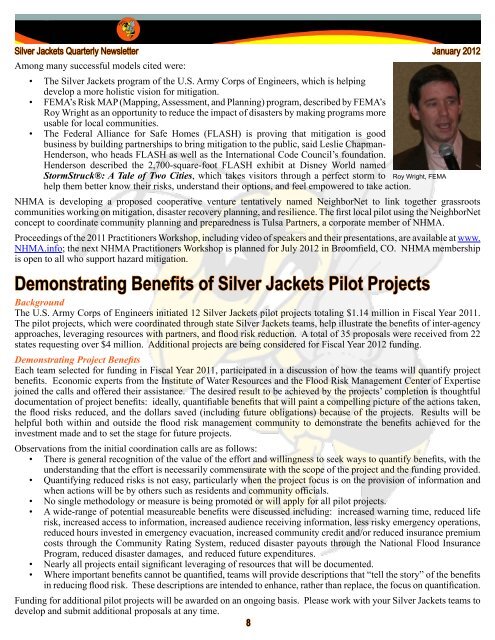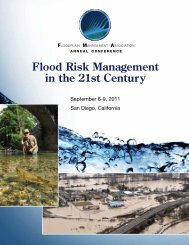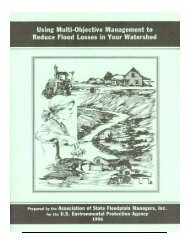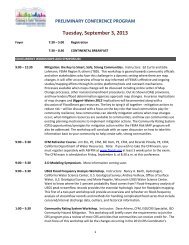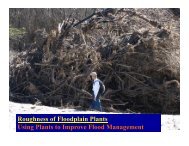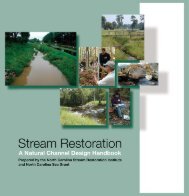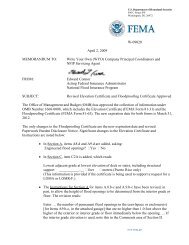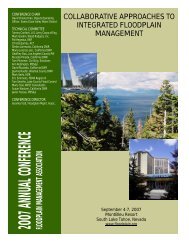Silver Jackets Quarterly Newsletter, January 2012 - Floodplain ...
Silver Jackets Quarterly Newsletter, January 2012 - Floodplain ...
Silver Jackets Quarterly Newsletter, January 2012 - Floodplain ...
Create successful ePaper yourself
Turn your PDF publications into a flip-book with our unique Google optimized e-Paper software.
<strong>Silver</strong> <strong>Jackets</strong> <strong>Quarterly</strong> <strong>Newsletter</strong><br />
Among many successful models cited were:<br />
<strong>January</strong> <strong>2012</strong><br />
• The <strong>Silver</strong> <strong>Jackets</strong> program of the U.S. Army Corps of Engineers, which is helping<br />
develop a more holistic vision for mitigation.<br />
• FEMA’s Risk MAP (Mapping, Assessment, and Planning) program, described by FEMA’s<br />
Roy Wright as an opportunity to reduce the impact of disasters by making programs more<br />
usable for local communities.<br />
• The Federal Alliance for Safe Homes (FLASH) is proving that mitigation is good<br />
business by building partnerships to bring mitigation to the public, said Leslie Chapman-<br />
Henderson, who heads FLASH as well as the International Code Council’s foundation.<br />
Henderson described the 2,700-square-foot FLASH exhibit at Disney World named<br />
StormStruck®: A Tale of Two Cities, which takes visitors through a perfect storm to Roy Wright, FEMA<br />
help them better know their risks, understand their options, and feel empowered to take action.<br />
NHMA is developing a proposed cooperative venture tentatively named NeighborNet to link together grassroots<br />
communities working on mitigation, disaster recovery planning, and resilience. The first local pilot using the NeighborNet<br />
concept to coordinate community planning and preparedness is Tulsa Partners, a corporate member of NHMA.<br />
Proceedings of the 2011 Practitioners Workshop, including video of speakers and their presentations, are available at www.<br />
NHMA.info; the next NHMA Practitioners Workshop is planned for July <strong>2012</strong> in Broomfield, CO. NHMA membership<br />
is open to all who support hazard mitigation.<br />
Demonstrating Benefits of <strong>Silver</strong> <strong>Jackets</strong> Pilot Projects<br />
Background<br />
The U.S. Army Corps of Engineers initiated 12 <strong>Silver</strong> <strong>Jackets</strong> pilot projects totaling $1.14 million in Fiscal Year 2011.<br />
The pilot projects, which were coordinated through state <strong>Silver</strong> <strong>Jackets</strong> teams, help illustrate the benefits of inter-agency<br />
approaches, leveraging resources with partners, and flood risk reduction. A total of 35 proposals were received from 22<br />
states requesting over $4 million. Additional projects are being considered for Fiscal Year <strong>2012</strong> funding.<br />
Demonstrating Project Benefits<br />
Each team selected for funding in Fiscal Year 2011, participated in a discussion of how the teams will quantify project<br />
benefits. Economic experts from the Institute of Water Resources and the Flood Risk Management Center of Expertise<br />
joined the calls and offered their assistance. The desired result to be achieved by the projects’ completion is thoughtful<br />
documentation of project benefits: ideally, quantifiable benefits that will paint a compelling picture of the actions taken,<br />
the flood risks reduced, and the dollars saved (including future obligations) because of the projects. Results will be<br />
helpful both within and outside the flood risk management community to demonstrate the benefits achieved for the<br />
investment made and to set the stage for future projects.<br />
Observations from the initial coordination calls are as follows:<br />
• There is general recognition of the value of the effort and willingness to seek ways to quantify benefits, with the<br />
understanding that the effort is necessarily commensurate with the scope of the project and the funding provided.<br />
• Quantifying reduced risks is not easy, particularly when the project focus is on the provision of information and<br />
when actions will be by others such as residents and community officials.<br />
• No single methodology or measure is being promoted or will apply for all pilot projects.<br />
• A wide-range of potential measureable benefits were discussed including: increased warning time, reduced life<br />
risk, increased access to information, increased audience receiving information, less risky emergency operations,<br />
reduced hours invested in emergency evacuation, increased community credit and/or reduced insurance premium<br />
costs through the Community Rating System, reduced disaster payouts through the National Flood Insurance<br />
Program, reduced disaster damages, and reduced future expenditures.<br />
• Nearly all projects entail significant leveraging of resources that will be documented.<br />
• Where important benefits cannot be quantified, teams will provide descriptions that “tell the story” of the benefits<br />
in reducing flood risk. These descriptions are intended to enhance, rather than replace, the focus on quantification.<br />
Funding for additional pilot projects will be awarded on an ongoing basis. Please work with your <strong>Silver</strong> <strong>Jackets</strong> teams to<br />
develop and submit additional proposals at any time.<br />
8


